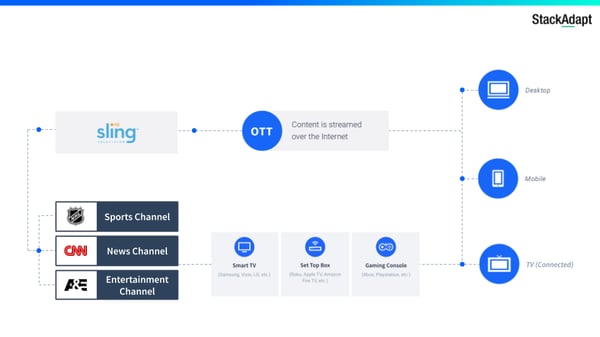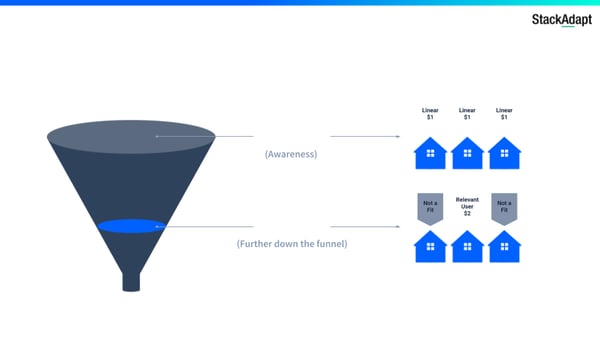You know what’s harder than skipping ads on streaming platforms? Reaching your audience without them skipping you.
Streaming killed the cable star, but not the ad break. Today’s viewers might be watching Hulu, YouTube TV, and Roku on their own terms, but they’re still very much watching. And while they’re bingeing true crime or cheering live sports, marketers have a golden opportunity: show up in the content they love, without being the thing they hate.
That’s where OTT (Over-the-Top) advertising comes in. It’s how growth teams, media buyers, and brand marketers run smarter, more targeted, more measurable campaigns, without relying on crumbling cookies or third-party workarounds.
What is OTT advertising?
OTT advertising refers to ads delivered through streaming services on internet-connected devices, bypassing traditional cable or satellite TV. Platforms like Hulu, Roku, and Amazon Fire TV allow brands to reach targeted audiences directly with video ads before or during content playback.
It’s how brands meet today’s binge-watching, multi-device, cord-cutting audiences, without feeling like old-school interruptions.
And if you’re a digital advertiser, growth marketer, or brand builder navigating the ever-shifting media landscape, understanding how OTT works isn’t just nice to have; it’s non-negotiable.
In this article, we’ll break down what OTT advertising is, why it matters in a post-cookie world, how it compares to traditional and programmatic TV ads, and which platforms and tools like demand-side platforms (DSPs), and display advertising platforms, can help you win screen time and mindshare.
TL;DR: OTT advertising at a glance
- What it is: Ads delivered via streaming platforms like Hulu, Roku, and YouTube TV, beyond traditional cable.
- How does OTT advertising work? Uses internet-connected devices + programmatic tech to target and serve video ads.
- What are the key considerations of OTT ads? Targeting options, platform choice, budget, and measurement tools.
- What are the benefits of OTT advertising? Precise targeting, real-time analytics, reach cord-cutters, and cross-device flexibility.
- What are the challenges of OTT advertisements? Fragmented platforms, ad fatigue, higher costs, and inconsistent measurement.
What is OTT advertising? Understanding the basics
As mentioned earlier, OTT (Over-the-Top) advertising refers to video ads delivered through streaming platforms that bypass traditional cable or satellite TV. These ads appear within internet-streamed content, whether it’s a bingeable series, live sports, or on-demand movies, across devices like smart TVs, streaming sticks, game consoles, laptops, and mobile phones.
Unlike traditional TV ads that are broad and untargeted, OTT ads are served digitally, enabling brands to reach specific audiences based on demographics, interests, or viewing behavior.
And the market is growing fast. OTT video ad spending is expected to reach $207.52 billion worldwide in 2025, underscoring just how central streaming has become to global advertising strategies.

OTT vs. traditional TV vs. connected TV
With so many terms floating around, OTT, CTV, and linear TV, it’s easy to get them mixed up. Here’s a quick breakdown to help clarify how they differ and how they fit together in the streaming ecosystem.
- OTT is the delivery method. streaming content via the internet.
- Traditional TV is linear broadcasting, scheduled programming via cable or satellite.
- Connected TV (CTV) refers to devices — such as smart TVs, Roku, or Fire TV Stick — used to access OTT content.
While OTT and CTV are closely related, OTT is what delivers the content; CTV is where it’s viewed.
How OTT advertising works
While OTT ads may look similar to traditional TV spots, they’re powered by digital infrastructure that allows for real-time targeting, dynamic delivery, and measurable performance. Here’s a closer look at how the process works, from audience definition to ad analytics.
1. Audience targeting
Every OTT ad campaign starts with defining the target audience. Unlike linear TV, where ads are broadcast to everyone watching a channel, OTT enables precise segmentation. Advertisers can target based on:
- Demographics: Age, gender, household income, location
- Behavioral data: Viewing history, streaming frequency, interests
- Device type: Smart TVs, gaming consoles, streaming sticks, or mobile devices
- Contextual signals: Content category (sports, drama, kids), time of day, or geolocation
These insights are often pulled from first-party data (streaming platform user accounts), third-party audience data providers, or even integrations with CRM or CDP platforms.
2. Ad delivery and bidding
Once the audience is defined, ads are served through digital pipes. OTT platforms use ad servers or demand-side platforms (DSPs) to determine which ads are shown to which viewers.
Here’s what happens behind the scenes:
- A request is triggered when a viewer starts streaming content to fill the upcoming ad slot.
- That request is sent to an ad server or DSP, which evaluates available campaigns based on targeting criteria, bidding strategy, and budget.
- If programmatic buying is involved, the platform may hold a real-time bidding to determine which ad is served.
- Once selected, the ad is delivered and rendered inside the streaming content before, during, or after the show.
This process happens in milliseconds, ensuring that the right ad reaches the right viewer at the right moment.
3. Dynamic ad insertion (DAI)
A key innovation in OTT is dynamic ad insertion, which allows ads to be stitched into content in real time. This means every viewer can see a different ad, even when watching the same program at the same time.
DAI supports both live and on-demand content, enabling:
- Personalized ad delivery based on user profiles
- More efficient frequency capping, preventing overexposure
- Creative versioning so that brands can test different ad variations across audiences
This flexibility gives advertisers more control and makes the viewing experience less repetitive for audiences.
4. Measurement and reporting
After the ad is served, performance tracking begins. One of OTT advertising’s biggest advantages over traditional TV is detailed analytics and attribution. Marketers can monitor:
- Impressions and completion rates
- Click-through rates (CTR) for interactive or clickable ads
- View-through conversions, tracking actions taken after viewing the ad
- Household reach and frequency, to avoid over-delivery
- Cross-device engagement, when users stream on multiple screens
These insights help advertisers refine targeting, reallocate budget, and optimize creative for future campaigns, all in near real time.
Where OTT ads show up: Popular OTT platforms
Here are some of the most prominent OTT platforms offering ad inventory:
- Hulu: Offers robust audience targeting and premium network content. Popular for its blend of original programming and network shows.
- Roku Channel: As a platform and device, Roku provides direct access to user behavior, enabling powerful CTV-level targeting.
- Peacock: NBCUniversal’s streaming service offers both live and on-demand content, with tiered ad experiences.
- Tubi and Pluto TV: Free ad-supported streaming TV (FAST) platforms with massive reach, ideal for broad awareness campaigns.
- YouTube TV: A hybrid of live TV and on-demand, with deep Google targeting and flexible ad formats.
- Amazon Prime: Leverages Amazon’s first-party data for contextual and behavioral targeting across devices.
These platforms differ in content type, audience demographics, targeting capabilities, and CPMs, making platform selection a key part of your OTT strategy.
What do OTT digital ads look like? Common OTT ad formats
OTT ads may look like traditional TV commercials at first glance, but given they’re delivered digitally and allow for deeper viewer engagement, they take on more dynamic formats. Here are the most common ad types used in OTT advertising today:
Pre-roll ads
These play before the content begins. They’re often high-impact because viewers are most attentive at the start.
- Great for brand awareness
- Can be skippable or non-skippable, depending on the platform
- Risk: viewers may skip if uninterested or if there’s no countdown timer
Mid-roll ads
These are inserted during the content at natural breaks (similar to traditional TV ad pods). These typically have high completion rates.
- Ideal for long-form content
- Viewers are less likely to abandon content mid-stream
- Allows multiple brands to appear in a single viewing session
Post-roll ads
These ads are shown after the content ends. Less intrusive, but can suffer from lower engagement.
- Better suited for branding or product recall
- Useful in loyalty-focused or retargeting campaigns
- Low risk of disrupting user experience
Skippable ads
Viewers can choose to skip after a few seconds, usually five.
- Provides a broad reach at a lower cost
- Works well when paired with strong hooks in the first 3–5 seconds
- Charged on a viewable or completed basis, depending on the platform
Non-skippable ads
These are short ads (usually 6–15 seconds) that viewers must watch in full.
- Guaranteed impressions
- Higher CPM, but better suited for high-value messaging
- Requires tight, engaging storytelling to avoid drop-off post-view
Interactive ads
These ads encourage viewer interaction, such as clicking a CTA, exploring a product, or scanning a QR code.
- Good for direct-response campaigns
- Works well on CTV and mobile devices
- Can link directly to product pages or landing experiences
Dynamic ad insertion (DAI)
DAI is not a format itself, but a delivery method that allows ads to be inserted in real time based on the viewer’s profile.
- Enables audience-specific targeting
- Supports ad rotation, A/B testing, and creative personalization
- Essential for scaling OTT campaigns programmatically
How OTT improves on linear TV advertising: OTT ads vs linear TV ads
While traditional linear TV advertising has long been valued for its reach and storytelling power, its limitations have become increasingly clear in a digital-first world. Limited targeting, rigid scheduling, and delayed performance data make it difficult for advertisers to justify their high costs, especially when accountability and agility are table stakes in modern campaigns.
OTT advertising addresses these gaps with a more flexible, data-driven approach. It gives advertisers the ability to precisely target audiences, measure results in real time, and deliver relevant messaging across devices.
Here’s how the two compare across key campaign dimensions:
| Campaign dimension | Linear TV advertising | OTT advertising |
| Audience targeting | Broad and contextual (based on program/channel) | Granular targeting by demographics, interests, behavior, and location |
| Ad delivery | Pre-scheduled, based on fixed programming slots | Dynamically inserted based on real-time availability and audience match |
| Reach | Cable/satellite subscribers only | Cord-cutters, cord-nevers, and cross-device streamers |
| Measurement | Ratings estimates, post-campaign reports | Real-time performance metrics, including completions and conversions |
| Cost efficiency | High upfront cost, limited control | Programmatic bidding, budget optimization, and reduced waste |
| Creative flexibility | Static ad placements, minimal testing options | Supports A/B testing, creative versioning, and household-level personalization |
OTT doesn’t just replicate TV. It reimagines it. Instead of relying on content context to find your audience, OTT puts your audience first, then delivers your message to them wherever, whenever, and however they’re watching. This shift from content-based to audience-based buying enables advertisers to connect with real people, not just viewers of a particular show or time slot.
In short, OTT preserves the strengths of traditional television like sight, sound, and storytelling, while removing many of its constraints.
Why should marketers add OTT advertising to their media mix?
As a digital-first version of TV advertising, OTT offers marketers the best of both worlds: the storytelling power of television and the targeting precision of programmatic media. Here’s why advertisers are increasingly shifting their video ad budgets to OTT.
1. Precise audience targeting and reduced waste
Unlike traditional TV advertising, which casts a wide net across all viewers of a given program, OTT enables granular audience targeting. Advertisers can define custom audience segments using data such as:
- Demographics (age, gender, income, etc.)
- Behavioral traits and interests
- Geographic location (even down to the ZIP code)
- Device type and streaming behavior
- First-party CRM data or custom-built audience lists
This household-level precision ensures that ads are only served to relevant viewers, eliminating wasted impressions. For advertisers, this means improved efficiency, tighter control over spend, and a higher likelihood of engagement and conversion.

2. Access to previously unreachable audiences
Linear TV is losing ground to streaming, especially among younger, digitally native viewers. OTT fills this gap by offering access to two fast-growing audience segments:
- Cord-cutters: Former cable subscribers who have switched to streaming services
- Cord-nevers: Viewers who have never subscribed to cable or satellite TV
These audiences often cannot be reached through traditional media channels. OTT enables advertisers to engage them where they spend their time, on connected TVs, mobile devices, and streaming platforms.
3. Cross-device flexibility and high engagement
OTT campaigns can run across multiple devices, including:
- Smart TVs and connected TV devices (Roku, Fire Stick, Apple TV)
- Desktop and laptop computers
- Tablets and smartphones
- Gaming consoles
This cross-device presence allows advertisers to build consistent brand narratives across the consumer journey, from awareness on the big screen to consideration on mobile.
Moreover, because OTT ads appear in full-screen, non-scrollable environments and are often non-skippable, they enjoy high viewability and completion rates. Viewers are typically more engaged, having intentionally selected the content they’re watching, which increases receptiveness to well-placed ads.
4. Programmatic buying and cost efficiency
OTT advertising can be purchased programmatically, which gives advertisers the ability to bid dynamically for ad placements in real time. This model offers several advantages:
- Budget control through real-time bidding (RTB) and pacing
- Access to diverse inventory across premium and niche publishers
- Efficient CPMs compared to traditional TV, especially for targeted impressions
While OTT CPMs may be higher than display or social video ads, they’re significantly more cost-effective than traditional broadcast TV commercials, especially considering the improved targeting and measurement capabilities.
5. Access to premium content and inventory
OTT platforms increasingly provide access to high-demand content, including live events, network series, and award shows. In many cases, advertisers can reach audiences watching premium content, such as the Super Bowl or The Oscars, even when linear TV inventory is sold out.
This makes OTT not just an alternative, but a strategic complement to linear media buys, especially for advertisers who want to maintain visibility during high-profile events without the limitations of traditional TV pricing and scheduling.
6. Real-time measurement and performance optimization
Unlike traditional TV, where advertisers often wait days for post-campaign ratings reports, OTT delivers detailed performance data in real time. Advertisers can track:
- Impressions and video completion rates
- Click-through rates (when applicable)
- Website visits, app downloads, or product purchases
- Frequency and reach across devices and households
This immediacy enables ongoing optimization, adjusting targeting, pacing, or creative mid-flight to improve outcomes. It also enhances attribution, helping advertisers understand not only who saw the ad, but what actions followed.
7. Integration with broader media strategies
OTT is highly effective on its own, but even more powerful when used as part of a coordinated digital strategy. Integrated media plans that include OTT, display, native, and video channels allow brands to:
- Deliver sequential messaging across devices
- Reinforce key brand touchpoints across the funnel
- Drive users from awareness to action through persistent visibility
As part of a full-funnel strategy, OTT plays a critical role in both upper-funnel awareness and mid-funnel engagement, especially when the creative is personalized to each audience segment.
Problems with OTT advertising
While OTT is a powerful and fast-growing channel, it comes with a few hurdles that advertisers should be aware of:
- Fragmented platform landscape: Multiple streaming services, devices, and inventory sources can make media planning and campaign execution complex.
- Limited ad access on gated platforms: Not all OTT services offer ad inventory, restricting available reach.
- Frequency control issues: Inconsistent frequency capping across platforms can lead to ad repetition and viewer fatigue.
- Higher CPMs than other digital formats: While more affordable than linear TV, OTT CPMs are typically higher than display or social videos.
- Ad saturation and viewer resistance: Viewers are increasingly wary of repetitive or irrelevant ads. Without compelling creative and audience alignment, engagement can suffer.
- Need for trusted access to inventory: Because premium OTT inventory isn’t always openly available, advertisers benefit from working with digital partners or DSPs that have direct access to the right exchanges and platforms.
Frequently asked questions (FAQ) on OTT advertising
How do you buy OTT advertising?
OTT ads can be purchased in two main ways:
- Direct deals with specific streaming platforms or publishers (e.g., Hulu, Peacock, Roku).
- Programmatic buying through a demand-side platform (DSP), which allows advertisers to access OTT inventory across multiple platforms, set targeting parameters, and bid on ad placements in real time.
A media partner can help access premium inventory and optimize performance.
What is the difference between OTT and CTV advertising?
OTT refers to streaming content delivered over the internet, while CTV is the device used to watch it (like a smart TV or Roku). OTT is the content, CTV is the screen.
What is the cost of OTT ads?
OTT ads are typically priced on a CPM (cost per thousand impressions) basis. CPMs can range from $20 to $65 or more. Costs vary by targeting, platform (Hulu vs. Pluto TV), ad format, and whether it’s live or on-demand content.
Is YouTube advertising considered OTT?
Yes, when viewed on connected TVs or streaming devices. However, YouTube on desktop or mobile is classified as digital video advertising, not OTT.
Are OTT ads clickable?
On CTV devices, OTT ads are typically not clickable, as users don’t interact with a mouse or touchscreen. Instead, QR codes or voice call-to-actions are used. Clickable ads are more common on mobile or desktop OTT platforms.
Are OTT ads skippable?
It depends on the platform and ad format. Some allow skippable ads, while others require non-skippable formats, often at a higher cost but with better completion rates.
Stream it to win it
OTT advertising isn’t just a shift in how ads are delivered; it’s a shift in how audiences are reached, measured, and converted. As viewership habits evolve, so must advertising strategies. With its precision targeting, premium content environments, and measurable performance, OTT offers brands a direct line to modern, engaged viewers across devices.
But to truly win with OTT, advertisers need more than great creative. You need the right tools, the right partners, and the right strategy. Whether you’re looking to extend your digital reach, make your TV dollars work harder, or connect with cord-cutting audiences, OTT puts you in control of the message and the moment.
Done right, it’s not just another screen. It’s your most powerful one.
Check out the key advertising metrics to track and improve ad network performance.
This article was originally published in 2020 and has been updated with new information.










